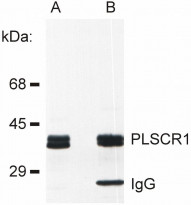ARG65367
anti-PLSCR1 antibody [13A6 (TEC-23)]
anti-PLSCR1 antibody [13A6 (TEC-23)] for Flow cytometry,ICC/IF,Immunoprecipitation,Western blot and Rat
Cell Biology and Cellular Response antibody; Microbiology and Infectious Disease antibody; Signaling Transduction antibody
Overview
| Product Description | Mouse Monoclonal antibody [13A6 (TEC-23)] recognizes PLSCR1 |
|---|---|
| Tested Reactivity | Rat |
| Tested Application | FACS, ICC/IF, IP, WB |
| Specificity | The clone 13A6 [TEC-23] binds to rat Phospholipid Scramblase 1 (PLSCR1), an 37-49 kDa membrane-associated protein accelerating bidirectional movement of plasma membrane phospholipids during conditions of elevated calcium. |
| Host | Mouse |
| Clonality | Monoclonal |
| Clone | 13A6 (TEC-23) |
| Isotype | IgG2a |
| Target Name | PLSCR1 |
| Antigen Species | Rat |
| Immunogen | BALB/c mice were immunized with pooled lipid rafts isolated from RBL-2H3 cells. Hybridoma cells were obtained after fusion of SP02 mouse myeloma cells with spleen cells of immunized mice using standard procedures. |
| Conjugation | Un-conjugated |
| Alternate Names | Phospholipid scramblase 1; Erythrocyte phospholipid scramblase; PL scramblase 1; Ca; MmTRA1b; MMTRA1B; 2+ |
Application Instructions
| Application Suggestion |
|
||||||||||
|---|---|---|---|---|---|---|---|---|---|---|---|
| Application Note | * The dilutions indicate recommended starting dilutions and the optimal dilutions or concentrations should be determined by the scientist. |
Properties
| Form | Liquid |
|---|---|
| Buffer | Undiluted ascitic fuild and 15 mM Sodium azide |
| Preservative | 15 mM Sodium azide |
| Storage Instruction | For continuous use, store undiluted antibody at 2-8°C for up to a week. For long-term storage, aliquot and store at -20°C or below. Storage in frost free freezers is not recommended. Avoid repeated freeze/thaw cycles. Suggest spin the vial prior to opening. The antibody solution should be gently mixed before use. |
| Note | For laboratory research only, not for drug, diagnostic or other use. |
Bioinformation
| Database Links | |
|---|---|
| Gene Symbol | Plscr1 |
| Gene Full Name | phospholipid scramblase 1 |
| Background | PLSCR1 (Phospholipid Scramblase 1) is a multiply palmitoylated endofacial plasma membrane protein containing several SH3 and WW domain binding motives. In the plasma membrane, PLSCR1 plays a role in transbilayer lipid redistributions and signal transduction. Nonpalmitoylated PLSCR1, however, is able to be transported into the nucleus and bind DNA. PLSCR1 potentiates the antiviral activity of interferon and its expression is highly induced by interferons and growth factors. _x000D_ |
| Function | May mediate accelerated ATP-independent bidirectional transbilayer migration of phospholipids upon binding calcium ions that results in a loss of phospholipid asymmetry in the plasma membrane. May play a central role in the initiation of fibrin clot formation, in the activation of mast cells and in the recognition of apoptotic and injured cells by the reticuloendothelial system. May play a role in the antiviral response of interferon (IFN) by amplifying and enhancing the IFN response through increased expression of select subset of potent antiviral genes. May contribute to cytokine-regulated cell proliferation and differentiation (By similarity). [UniProt] |
| Research Area | Cell Biology and Cellular Response antibody; Microbiology and Infectious Disease antibody; Signaling Transduction antibody |
| Calculated MW | 35 kDa |
Images (2) Click the Picture to Zoom In
-
ARG65367 anti-PLSCR1 antibody [13A6 (TEC-23)] ICC/IF image
Immunofluorescence: Rat basophilic leukemia (RBL) cells stained with ARG65367 anti-PLSCR1 antibody [13A6 (TEC-23)].
-
ARG65367 anti-PLSCR1 antibody [13A6 (TEC-23)] IP image
Immunoprecipitation: Rat basophilic leukemia (RBL) cell lysate (A) and PLSCR1 immunoprecipitated from RBL lysate (B). ARG65367 anti-PLSCR1 antibody [13A6 (TEC-23)] was used both for immunoprecipitation and immunodetection.









